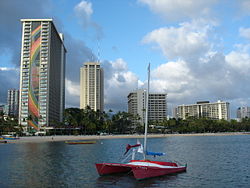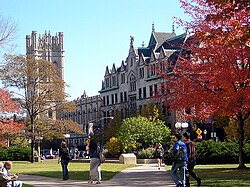| Revision as of 13:29, 29 March 2011 editCntras (talk | contribs)Pending changes reviewers18,526 editsm Reverted edits by 130.156.48.201 (talk) to last version by 137.82.100.76← Previous edit | Revision as of 21:09, 3 April 2011 edit undoJim Michael (talk | contribs)Extended confirmed users136,973 edits →ProfessionsNext edit → | ||
| Line 7: | Line 7: | ||
| ==Professions== | ==Professions== | ||
| Certain professions can be categorized as "upper middle class" though any such measurement must be considered subjective because of people's differing perception of class. Most people in the upper-middle class strata are highly educated white collar ] such as ],<!-- "Physicians" includes Optometry and the like, no need to add all specialties --> ], ], ], ], ]s, ], ] ], ], ], ], ], ], ], ], |
Certain professions can be categorized as "upper middle class" though any such measurement must be considered subjective because of people's differing perception of class. Most people in the upper-middle class strata are highly educated white collar ] such as ],<!-- "Physicians" includes Optometry and the like, no need to add all specialties --> ], ], ], ], ]s, ], ] ], ], ], ], ], ], ], ], ], ], ], ], ], ], ], ] ], ], ], ], ], ], ] ]s, high-level ] and wealthy members of the ]. Other common professions include ], ], ], and ]. Generally, people in these professions have an advanced post-secondary education and a comfortable standard of living.<ref name="Society in Focus"/> | ||
| ==Values== | ==Values== | ||
Revision as of 21:09, 3 April 2011

- See American Professional/Managerial middle class for a complete overview of the American middle classes.
The upper middle class in the United States is a sociological concept referring to the social group constituted by higher-status members of the middle class. This is in contrast to the term lower middle class which refers to the group at the opposite end of the middle class scale. There is considerable debate as to how the upper middle class might be defined. According to Max Weber the upper middle class consists of well-educated professionals with graduate degrees and comfortable incomes.
The American upper middle class is defined using income, education, occupation and the associated values as main indicators. In the United States, the upper middle class is defined as consisting of white-collar professionals who have above-average personal incomes, advanced educational degrees and a high degree of autonomy in their work, leading to higher job satisfaction. The main occupational tasks of upper middle class individuals tend to center on conceptualizing, consulting, and instruction.
Professions
Certain professions can be categorized as "upper middle class" though any such measurement must be considered subjective because of people's differing perception of class. Most people in the upper-middle class strata are highly educated white collar professionals such as physicians, lawyers, economists, computer scientists, urban planners, management consultants, accountants, university professors, investment bankers, actuaries, geologists, hydrologists, chiropodists, podiatrists, chiropractors, traders, fund managers, architects, financial analysts, psychologists, scientists, nurse anesthetists, high school principals, engineers, optometrists, dentists, pharmacists, veterinarians, school district superintendents, high-level civil servants and wealthy members of the intelligentsia. Other common professions include corporate executive, venture capitalist, corporate raider, and business owner. Generally, people in these professions have an advanced post-secondary education and a comfortable standard of living.
Values
Most people encompassing this station in life have a high regard for higher education, and probably more than any other socio-economic class strive for themselves and their children to obtain graduate or at least four-year undergraduate degrees.
Members of the upper middle class tend to place a high value on foreign travel, the arts, and high culture in general. This value is in line with the emphasis placed on education as foreign travel increases one's understanding of other cultures and helps create a global perspective.
In the U.S. the upper middle class is rather divided in terms of political ideology. Modern liberalism as well as fiscal conservatism are among the most prominent ideologies. Most mass affluent households and college-educated professionals tend to be center-right or conservative on fiscal issues but moderate to center-left on social issues. A slight majority of college-educated professionals, who compose 15% of the population and 20% of the electorate, favor the Democratic Party. Among those with six figure households incomes, a slight majority favor the Republican Party. Academia and those with graduate degrees overall favor the Democratic Party. In 2005, 72% of full-time faculty members at four-year institutions, the majority of whom are upper middle class, identified as liberal.
The upper middle class is often the group that shapes society and brings social movements to the forefront. Movements such as the Peace Movement, The Anti-Nuclear Movement, Environmentalism, the Anti-Smoking movement, and even in the past with Blue laws and the Temperance movement are all products of the upper middle class. Some claim this is because this is the largest class (and the lowest class) with any true political power for positive change, while others claim some of the more restrictive social movements (such as with smoking and drinking) are based upon "saving people from themselves."
American upper middle class
- See American Professional/Managerial middle class for a complete overview of the American middle classes.


In the United States the term middle class and its subdivisions are an extremely vague concept as neither economists nor sociologists have precisely defined the term. There are several perceptions of the upper middle class and what the term means. In academic models the term applies to highly educated salaried professionals whose work is largely self-directed. Many have graduate degrees with educational attainment serving as the main distinguishing feature of this class. Household incomes commonly may exceed $100,000, with some smaller one-income earners household having incomes in the high 5-figure range.
"The upper middle class has grown...and its composition has changed. Increasingly salaried managers and professionals have replaced individual business owners and independent professionals. The key to the success of the upper middle class is the growing importance of educational certification...its lifestyles and opinions are becoming increasingly normative for the whole society. It is in fact a porous class, open to people...who earn the right credentials. "- Dennis Gilbert, The American Class Structure, 1998.
In addition to having autonomy in their work, above-average incomes, and advanced educations, the upper middle class also tends to be influential, setting trends and largely shaping public opinion. Overall, members of this class are also secure from economic down-turns and, unlike their counterparts in the statistical middle class, do not need to fear downsizing, corporate cost-cutting, or outsourcing—an economic benefit largely attributable to their graduate degrees and comfortable incomes, likely in the top income quintile or top third. Typical professions for this class include professors, accountants, architects, urban planners, engineers, economists, pharmacists, political scientists, physicians and lawyers.
Income
Further information: Affluence in the United States, Household income in the United States, and Personal income in the United StatesWhile many Americans see income as the prime determinant of class, occupational status, educational attainment, and value systems are equally important. Income is in part determined by the scarcity of certain skill sets. As a result an occupation that requires a scarce skill, the attainment of which is often achieved through an educational degree, and entrusts its occupant with a high degree of influence will usually offer high economic compensation. The high income is meant to ensure that individuals obtain the necessary skills (e.g. medical or graduate school) and complete their tasks with the necessary valor. There are also differences between household and individual income. In 2005, 42% of US households (76% among the top quintile) had two or more income earners; as a result, 18% of households but only 5% of individuals had six figure incomes. To illustrate, two nurses each making $55,000 per year can out-earn, in a household sense, a single attorney who makes a median of $95,000 annually.
Sociologists Dennis Gilbert, Willam Thompson and Joseph Hickey estimate the upper middle class to constitute roughly 15% of the population. Using the 15% figure one may conclude that the American upper middle class consists, strictly in an income sense, of professionals with personal incomes in excess of $62,500, who commonly reside in households with six figure incomes. The difference between personal and household income can be explained by considering that 76% of households with incomes exceeding $90,000 (the top 20%) had two or more income earners.
| Data | Top third | Top quarter | Top quintile | Top 15% | Top 10% | Top 5% | |||
|---|---|---|---|---|---|---|---|---|---|
| Household income | |||||||||
| Lower threshold (annual gross income) | $65,000 | $80,000 | $91,705 | $100,000 | $118,200 | $166,200 | |||
| Exact Percentage of households | 34.72% | 25.60% | 20.00% | 17.80% | 10.00% | 5.00% | |||
| Personal income (age 25+) | |||||||||
| Lower threshold (annual gross income) | $37,500 | $47,500 | $52,500 | $62,500 | $75,000 | $100,000 | |||
| Exact Percentage of individuals | 33.55% | 24.03% | 19.74% | 14.47% | 10.29% | 5.63% | |||
SOURCE: US Census Bureau, 2006
See also
US-specific
- Affluence in the United States
- American middle class
- Educational attainment in the United States
- Household income in the United States
- Personal income in the United States
- Social structure of the United States
References
- ^ Thompson, William (2005). Society in Focus. Boston, MA: Pearson. 0-205-41365-X.
{{cite book}}: Unknown parameter|coauthors=ignored (|author=suggested) (help) - Eichar, Douglas (1989). Occupation and Class Consciousness in America. Westport, Connecticut: Greenwood Press. 0-313-26111-3.
{{cite book}}: Cite has empty unknown parameter:|coauthors=(help) - ^ Ehrenreich, Barbara (1989). Fear of Falling, The Inner Life of the Middle Class. New York, NY: Harper Collins. 0-06-0973331.
{{cite book}}: Cite has empty unknown parameter:|coauthors=(help) Cite error: The named reference "The Inner Life of the Middle Class" was defined multiple times with different content (see the help page). - ", R. & Saad, L. (9 December 2004). Marketing to the Mass Affluent. Gallup Management Journal". Retrieved 19 July 2007.
- "Judis, B. J. (11 July 2003). The trouble with Howard Dean. Salon.com". Retrieved 19 July 2007.
- ^ Gilbert, Dennis (1998). The American Class Structure. New York: Wadsworth Publishing. 0-534-50520-1.
{{cite book}}: Cite has empty unknown parameter:|coauthors=(help) - "CNN. (2004). Exit Poll". Retrieved 11 July 2007.
- "CNN. (2006). Exit Poll". Retrieved 11 July 2007.
- "Kurtz, H. (29 March 2005). College Faculties A Most Liberal Lot, Study Finds. The Washington Post". 29 March 2005. Retrieved 2 July 2007.
- "Middle class according to The Drum Major Institute for public policy". Retrieved 25 July 2006.
- "Professional Occupations according to the US Department of Labor". Retrieved 26 July 2006.
- Levine, Rhonda (1998). Social Class and Stratification. Lanham, MD: Rowman & Littlefield. 0-8476-8543-8.
{{cite book}}: Cite has empty unknown parameter:|coauthors=(help) - ^ "US Census Bureau, income quintile and top 5% [[Household income in the United States|household income distribution]] and demographic characteristics, 2006". Retrieved 28 December 2006.
{{cite web}}: URL–wikilink conflict (help) - "US Department of Labor, median income of registered nurses". Retrieved 2 January 2007.
- "Bureau of Labor statistics data published by Monster.com, 20 highest paying jobs". Retrieved 27 December 2006.
- "US Census Bureau, distribution of personal income, 2006". Retrieved 9 December 2006.
- ^ "US Census Bureau, overall household income distribution, 2006". Retrieved 28 December 2006.
- ^ "US Census Bureau, personal income distribution, age 25+, 2006". Retrieved 28 December 2006.
| |||||||||||||||||||||||||||
| |||||||||||||||||||||||||||
Categories: